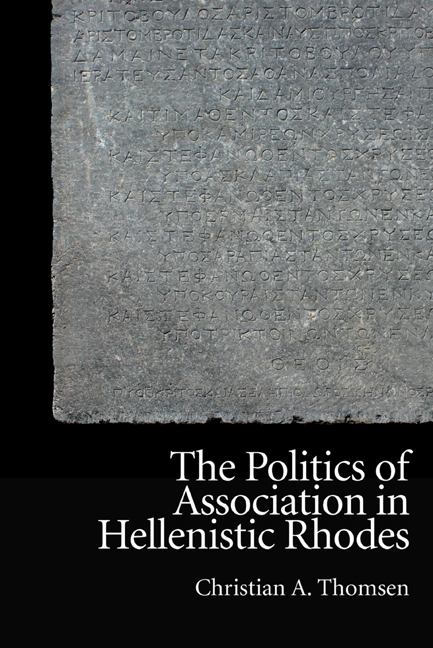Book contents
- Frontmatter
- Contents
- List of Tables and Figures
- Acknowledgements
- Abbreviations of Epigraphic Corpora
- Maps
- 1 Introduction
- 2 Rhodian Democracy
- 3 The Oikos
- 4 Public Associations
- 5 Private Associations
- 6 Private Associations and Human Resources
- 7 The Civic Aspirations of Private Associations
- 8 The Corporate Polis
- Bibliography
- Index Locorum
- General Index
2 - Rhodian Democracy
Published online by Cambridge University Press: 08 October 2020
- Frontmatter
- Contents
- List of Tables and Figures
- Acknowledgements
- Abbreviations of Epigraphic Corpora
- Maps
- 1 Introduction
- 2 Rhodian Democracy
- 3 The Oikos
- 4 Public Associations
- 5 Private Associations
- 6 Private Associations and Human Resources
- 7 The Civic Aspirations of Private Associations
- 8 The Corporate Polis
- Bibliography
- Index Locorum
- General Index
Summary
In 408/7 BCE, in the midst of the Peloponnesian War, the three independent poleis of the island of Rhodes, namely Ialysos, Kamiros and Lindos, joined together in a common island-wide state.1 Several, indeed most, aspects of the formation of the new Rhodian state elude us. The dearth of epigraphic sources from the first century of the new unified state makes it difficult to piece together the functions or even existence of most political institutions, and the constant shifts in government between democrats and oligarchs make it near impossible to generalise from the few scraps of literary evidence we do have. Following the expulsion of the Macedonian garrison in 322 BCE, however, the Rhodian state embarked on a long period of relative political stability that lasted well into the Imperial period. From the beginning of this period, though slowly at first, epigraphic evidence combined with a few literary texts allows us to piece together a picture of political institutions in the federal state as well as in the constituent poleis of Lindos and Kamiros (and to a lesser extent Ialysos).
POLITICAL INSTITUTIONS
Following the synoikism a new city, the city of Rhodes, or simply the asty as it was known locally, was founded on the island's northern promontory and intended to be the seat of the new federal Rhodian state's religious and political institutions.5As part of this process of integration, the three formerly independent poleis took on the roles of phylai in the new joint Rhodian state under the names Lindia, Kamiris and Ialysia. As such they served as the first set of civic subdivisions, which competed against each other at a number of state festivals celebrated in the asty, that is, the city of Rhodes. The phylai remained, however, centred on the three cities, which persisted both as towns and as important centres of cult and local administration.
Council, assembly and courts
Collective decision-making in the federal Rhodian state was in the hands of the council (boula) and the people (ho damos or ho sympas damos) which met in assembly (ekklesia). The normal procedure seems to have gone through the council, who heard proposals on a wide variety of matters.
- Type
- Chapter
- Information
- The Politics of Association in Hellenistic Rhodes , pp. 18 - 48Publisher: Edinburgh University PressPrint publication year: 2020



